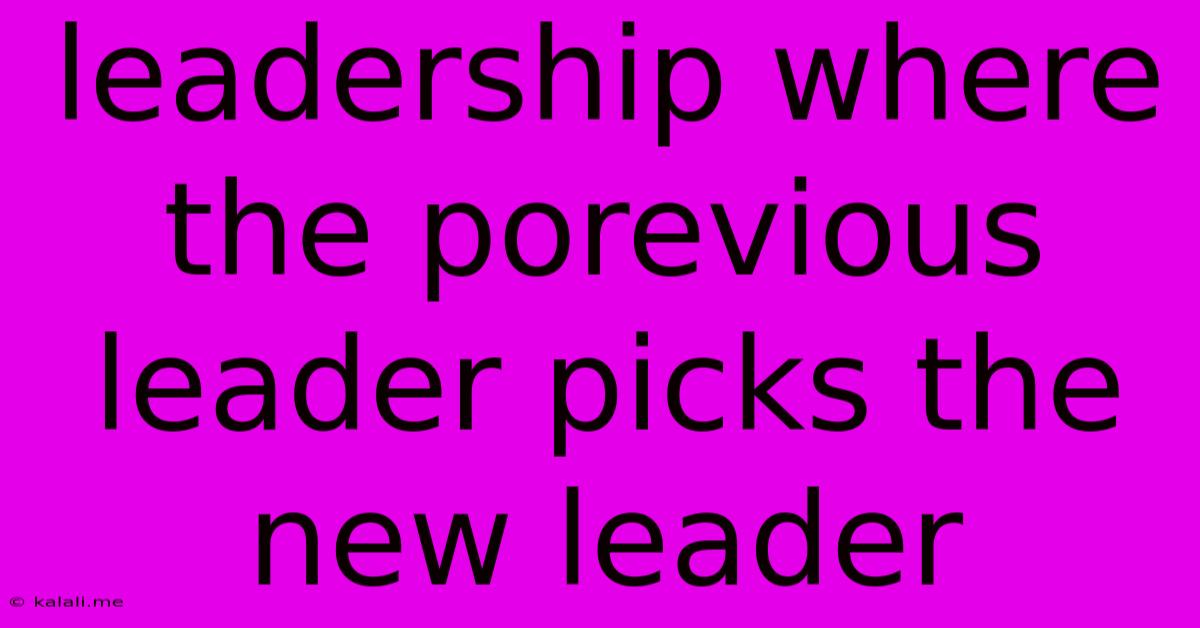Leadership Where The Porevious Leader Picks The New Leader
Kalali
Jun 01, 2025 · 3 min read

Table of Contents
Succession Planning: When the Old Guard Chooses the New
Choosing a successor is a crucial moment for any organization. While some companies opt for open competitions or external recruitment, others place their trust in the existing leadership to select their replacement. This approach, where the previous leader plays a significant role in selecting their successor, offers both advantages and disadvantages. This article will delve into the intricacies of this leadership succession method, exploring its benefits, potential pitfalls, and strategies for successful implementation.
Why Involve the Incumbent Leader?
The incumbent leader possesses invaluable insight into the organization's culture, challenges, and future direction. Their involvement in the selection process brings several key benefits:
- Deep Understanding of Organizational Needs: They possess firsthand knowledge of the skills, experience, and personality traits required for the role. This ensures a more accurate match between the candidate and the organization's needs.
- Mentorship and Knowledge Transfer: The selection process can facilitate a smoother transition by allowing the incumbent to mentor their successor, fostering a seamless transfer of knowledge and institutional memory.
- Enhanced Employee Morale: A transparent and well-managed succession plan can boost employee morale and confidence in the organization's future. It signals stability and preparedness for change.
- Reduced Risk and Uncertainty: A carefully chosen successor minimizes the risk of leadership gaps and abrupt changes in strategy, contributing to greater organizational stability.
Potential Challenges and Risks
Despite the advantages, this approach is not without its challenges:
- Bias and Personal Preferences: The incumbent leader might favor candidates who share their personal values or working style, potentially overlooking more qualified individuals. This can lead to a lack of diversity and hinder innovation.
- Lack of Objectivity: Subjectivity can creep in, affecting the fairness and transparency of the selection process. A structured, objective evaluation system is crucial to mitigate this risk.
- Resistance to Change: Choosing a successor who is significantly different from the incumbent can create resistance within the organization. Careful communication and change management strategies are essential.
- Potential for Power Struggles: The selection process might trigger power struggles or internal conflicts, especially if multiple individuals believe they are qualified for the position.
Strategies for a Successful Transition
To maximize the benefits and minimize the risks, organizations should implement the following strategies:
- Establish Clear Selection Criteria: Define specific skills, experience, and leadership qualities required for the role. This ensures a more objective and transparent assessment of candidates.
- Develop a Structured Selection Process: Implement a systematic approach involving multiple stages, such as applications, interviews, assessments, and reference checks.
- Diverse Candidate Pool: Actively seek a diverse pool of candidates to avoid bias and ensure a fair evaluation process. This promotes inclusion and leverages a wider range of perspectives.
- Mentorship and Training Program: Invest in a comprehensive mentorship and training program to facilitate knowledge transfer and prepare the successor for their new responsibilities.
- Transparency and Communication: Maintain open and transparent communication throughout the process to keep employees informed and address potential concerns.
Conclusion
Involving the previous leader in choosing their successor can be a highly effective approach to leadership succession, provided it is executed carefully. By establishing clear criteria, implementing a structured selection process, and fostering open communication, organizations can leverage the incumbent's expertise while mitigating potential risks. This ensures a smooth transition, maintains organizational stability, and fosters a positive environment for future growth and success. The key lies in balancing the incumbent's insights with objective evaluation and a commitment to fairness and transparency.
Latest Posts
Latest Posts
-
Why Is The Raft Notr Bveinfg Sliced Resin
Jun 02, 2025
-
At What Tread Depth Should Tires Be Replaced
Jun 02, 2025
-
Does Almond Bark Have Almonds In It
Jun 02, 2025
-
What Happens If You Plant Moldy Seeds
Jun 02, 2025
-
Pinout 3 5 Mm Female Jack Wiring Diagram
Jun 02, 2025
Related Post
Thank you for visiting our website which covers about Leadership Where The Porevious Leader Picks The New Leader . We hope the information provided has been useful to you. Feel free to contact us if you have any questions or need further assistance. See you next time and don't miss to bookmark.